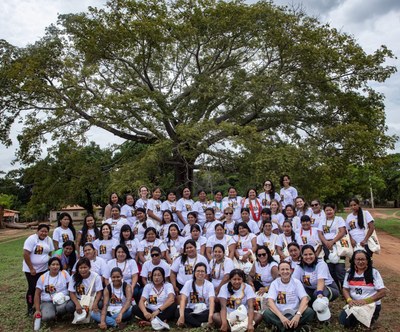Nature and Unity: Four Indigenous Peoples Join Forces to Explore Gender and Firefighting
November / December 2023 – Indigenous women in Brazil formed volunteer fire brigades to protect their community and the environment for future generations. They join the brigades to disseminate traditional knowledge to help restore degraded areas and to overcome prejudices and sexist views, creating leadership roles along the way.
They set aside their shyness to speak in public to overcome men's resistance and to share decision-making spaces. They exchange their domestic duties for public work and enter a male dominated sphere to lead and inspire other women and children.
Speaking to an audience of around 50 women Maria Helena Gavião, Deputy Coordinator of COAPIMA (Maranhão Indigenous Peoples Coordination) states “I saw Xerente women discuss their brigade online. They inspired us. I was the coordinator of AMIMA (Maranhão Indigenous Women Network), and decided to embrace that cause.”
The female members of the forest fire brigades represent four Indigenous Peoples: Apinajé, Gavião, Krikati, and Xerente. They banded together at the unprecedented meeting of female Indigenous forest firefighters. The group convened for three days in the Krikati Indigenous Land, in the state of Maranhão, to exchange experiences on integrated fire management, environmental education, and fire prevention initiatives within Legal Amazon states.
“This meeting is a major progress in our fight to join men and work as equals. We are increasingly working to strengthen our search for more spaces for Indigenous women,” adds Maria Helena.
These female Indigenous volunteer fire brigades formed at different times. The first group to complete a dedicated training program for women in 2021 were the Xerente (more details here). They were followed by the Apinajé.
During the meeting, they acknowledged their collective female strength including ancestral knowledge about the cultural and traditional use of fire on their lands. This is one of the distinctive aspects of environmental education initiatives, contributing to the prevention of wildfires, going beyond support for firefighting efforts.
“We had 42 women in our volunteer fire brigade. In order not to leave anyone out, we organized ourselves on three fronts: agroforestry systems, environmental education, and firefighting. This enables everyone to participate," says Cida Apinajé, one of the leaders of the Apinajé volunteer fire brigade.
The event was supported by USAID/Brazil in partnership with the Casa Socioambiental Fund. It was hosted by the Apinajé, Awkê/Xerente, Gavião, and Krikati Indigenous Women Firefighting Groups, together with AMIMA, COAPIMA, the National Indigenous Peoples Foundation (FUNAI), the National Center for the Prevention and Combat of Forest Fires (Prevfogo), linked to the Brazilian Institute for the Environment and Renewable Natural Resources (IBAMA), and the United States Forest Service.
Inclusion— Women face many challenges related to gender inclusion in integrated fire management strategies within the Indigenous forest fire brigades. “It was difficult because many women had to stand up to their husbands, who often failed to understand that it is important to show what we do and talk to other women—as we started doing now, at this meeting," says Maria Helena Gavião.
Katiane Xerente, a member of the Xerente Indigenous fire brigade, remembers facing resistance at the beginning. “At first, the other men in the fire brigade didn't want women to participate. Many people are still sexist, and believe that women should not leave their home. But things are changing.”
Rose Krikati is the youngest member of the group. She is currently 18 years old and lives in the São José village. She started to get involved in community meetings at the age of 14. She credits their prevention and environmental education work with the return of many animals and fruit trees to the region. "Female volunteer firefighters feel strong and inspired, with a broad approach to guarantee the future of other generations. We feel proud to be wherever we want."
Future – The Indigenous fire brigades prepared an action plan for 2024. They included designing training and capacity-building proposals, building plant nurseries, and producing teaching material in each of their respective languages. “Women engage in prevention and environmental education work. When we visit the schools and talk to our children about what we do and how we should take care of the environment, they become motivated. After listening to our stories, some say that they want to be like us when they grow up. This is very rewarding,” explains Ana Shelley Xerente, an Indigenous firefighter hired by Prevfogo/IBAMA to join the volunteer fire brigade.
FUNAI and Prevfogo/IBAMA representatives were present, they provided an overview of the progress and challenges related to women's participation in fighting and preventing forest fires. “We clearly see that prevention is increasingly fundamental and more effective than acting only when fires are already happening. Women can add a lot to the work of the official brigades working on these fronts,” points out Paula Mochel, head of the Prevfogo/IBAMA Prevention Division.
According to Prevfogo/IBAMA, 34% of the female firefighters are Indigenous. Their objective is to increase the numbers, because volunteer fire brigades provide opportunities for Indigenous women to reach higher positions in official fire brigades.
Planning the logistics for these meetings starts months in advance, forging alliances and partnerships to promote learning paths, creating training, and capacity-building programs, providing translation services and making sure there is an inclusive environment for participants requires a major effort. USAID and the United States Forest Service (Brazil Program) engaged in long-term initiatives to provide training to Xerente and Apinajé women, working with Prevfogo/IBAMA and FUNAI for the formation of these women-led fire brigades.
Jayleen Vera, General Coordinator of the USFS in Brazil, affirms the event is an important milestone for the protection of women’s struggles and their territories. "We heard excellent examples related to reducing the impact of forest fires, and community engagement. These Indigenous women bring a new perspective that connects elders, children, and schools through efforts to bring integrated fire management to the ground. Our role as a partner institution is to further promote this."




